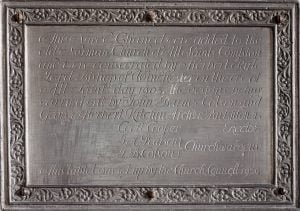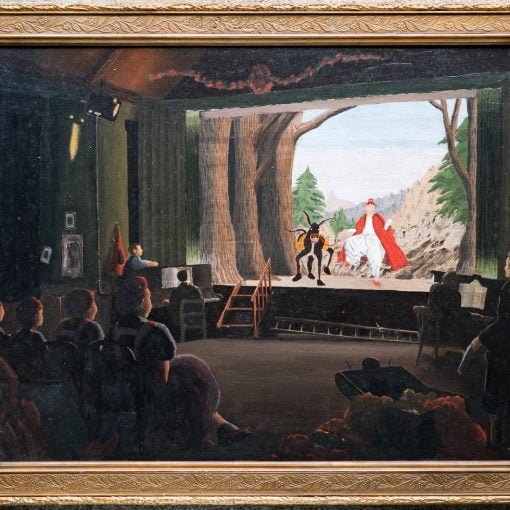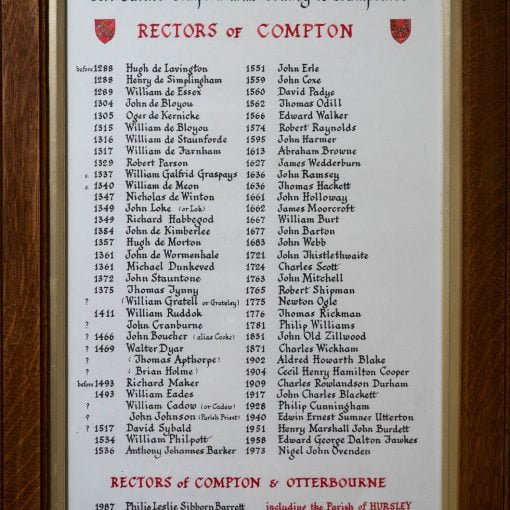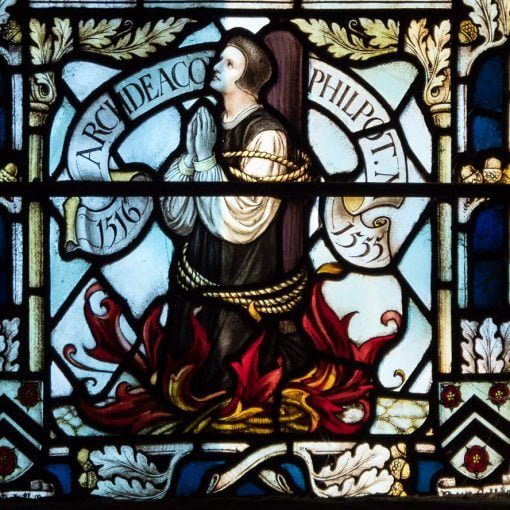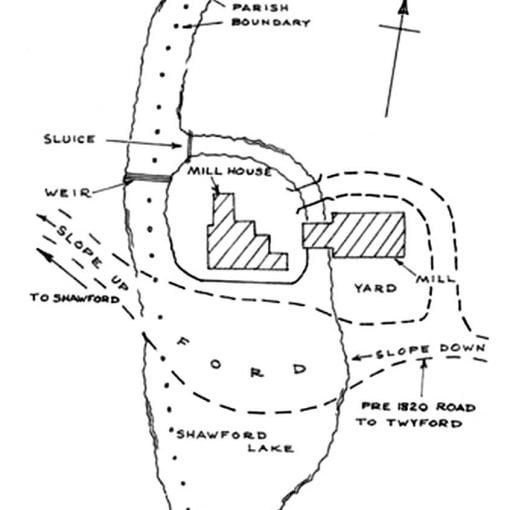Two articles from the Parish Magazine Archive. We are indebted to the Hampshire Records Office, who retain copies of most past issues since 1928 in their archive (mainly under reference 1M76/PZ)
The first article, by Rev. Cecil Cooper, was printed in the Compton & Shawford Parish Magazine, December 1938.
Table of Contents
The 1905 Extension of Compton Church
[With thanks to the Editor of the “ Hants Chronicle “ for permission to consult the file of that newspaper, November, 1905.]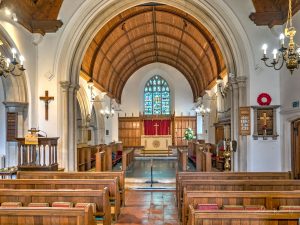
It appears that as far back as 1892, the need of adding to the Norman Church of Compton was discussed, since the existing building seated only 70 people, and the population was increasing.
The first definite move in the matter took place in 1903; when the Rev. A. H. Blake was Rector. The Vestry Meeting called for Compton and Shawford to consider the problem, decided by a majority of about 30 votes to build a new Church on the Down [near Mr. Vaughan’s Garage] the land being promised as a gift by a parishioner.
A further Meeting was held in August, 1904, shortly after my arrival as Rector of Compton, and after a long discussion, those present resolved to reverse their former decision by 50 votes to 2, several not voting. The acute division of opinion melted in the zeal for the extension of the ancient Church, and all worked together with enthusiasm for this object.
A strong Building Committee was formed, an estimate for £3,000 was accepted; the contractor was Mr. Ansell of Southampton and the architects were Mr. J. B. Colson and Mr. Herbert Kitchin (both of whom were parishioners) with Mr. Caröe as consulting architect.
The plan entailed the moving of the south wall and addition of Chancel and Nave, the ancient doorway, windows and piscina being carefully preserved in the new building, each with a label giving the date.
The stone of the exterior was Chilmark, that of the interior Bere-stone. Deep foundations were necessary, and this involved the removal of ancient graves. A careful and reverent disposal was made of human remains in 38 coffins, and I was present for a fortnight in the Churchyard during this work.
It is pleasant to remember that every week for six months a short service was held for the workmen during their dinner-hour, and it is worth recording that the weather from May to November, 1905, was extraordinary, only two days of heavy rain hindering the work.
During the process of building, all Services were held in the Parish Hall which was temporarily licensed for that purpose, when the congregations were very good.
Meanwhile, gifts poured in. Generous individuals gave the East Window, the Altar and its Ornaments, Sanctuary Seats, Choir Stalls, Litany Desk, Lectern (the latter was designed by an artist who visited the Zoological Gardens to study an eagle). Gifts of money came in from rich and poor, from men, women and children, so that on the Consecration Day the total deficit amounted to only £250. This did not include the Organ which was provided later. It is remarkable that the money was raised without the aid of a Bazaar.
The builders finished their work late at night on October 30th, and on the next day, the Vigil of All Saints, the Bishop of Winchester consecrated the new portion of the Church when the building was filled with a joyous congregation, and many neighbouring clergy and laity were present.
Looking back to those days, I can only remember good-will, co-operation, and zeal on the part of everyone.
It is impossible to mention the names of all our benefactors, but I must record the generosity of Mr. J. A. Pearson, so long time Churchwarden, and of Messrs. Colson and Kitchin who refused to accept payment for their services, and also of Miss Ravenhill who designed and worked most of the Frontals, Burses, Veils, Linen, Kneelers, etc. for the new Sanctuary, most of which are in use today.
After the Consecration Service, the Bishop was entertained to tea at the Parish Hall, and he expressed his delight at the beautiful and harmonious way in which the extension of the Church had been carried out, confessing his earlier fears that we might be spoiling one of the gems of the Diocese.
And so ended a great day in the history of this parish, when the people of Compton and Shawford rejoiced to worship together in their extended Church. After 33 years it seems to me that the text of the Bishop’s sermon on this occasion was justified :—
Psalm 102, V. 28-” The children of Thy servants shall continue, and their seed shall stand fast in Thy sight.”
CECIL COOPER
The second article appeared in the Compton & Shawford Parish Magazine, January 1981
This was the first of four talks delivered during the “Songs of Praise” Festival Service on 2nd November 1980. The speaker was Mr. Robert Cope, (Churchwarden).
Seventy-Five Years Ago
Seventy-five years ago yesterday was Tues. 1st November, 1905. Not only was it All Saints’ Day, our patronal festival, but it was also the day on which the new church in which many of you are now sitting was consecrated by the Bishop of Winchester. It is known that a church has stood on this site, certainly since the 12th Century – indeed reference was made to this fact in the Doomsday survey. The Norman nave in the old church is evidence of this fact.
By the end of the 19th Century the old church had become too small and records tell us that the congregations for Sunday services even had to queue to get into the church. The need for a larger church was therefore clearly established.
The first attempt to achieve this objective was made in 1892, when a decision was taken to add an aisle on to the South side of the church. This plan came to nothing due to a lack of funds.
The second attempt was made during the incumbency of the Reverend Blake. During this period a special committee was appointed for the purpose of recommending how the shortage of accommodation could be overcome. The recommendation that was eventually put forward was that a totally new church should be built on a site elsewhere with the Parish. This decision, although approved by a majority of the Parish, was bitterly opposed by a significant minority to the extent that the whole subject caused a deep division within the Parish. Looking back now it is probably fortuitous that although the scheme had received approval it in the end was never implemented. The two reasons for it not being carried through were firstly, a lack of funds and, secondly, it was considered unreasonable to expect one Rector to have to look after two churches. A number of incumbents today who have to look after as many as four Parishes, would no doubt find this latter point ironical.
As so often happens, one event, in the end, proved decisive. The event, so far as Compton was concerned, was the appointment of the Rev. Cooper as Rector. Under his guidance, a meeting of the Parish in August 1904 decided by 50 votes to 2 to build the new church as we know it today. The hope expressed at that meeting was that these plans would provide ample accommodation with the minimum disturbance to the old church.
Ironically, the principal architect of the new Church extension was Mr. Colson, who apart from being a parishioner was one of the most vociferous opponents of the idea of building a church on a new site. We can admire, to this day, the skilful way in which he used the South wall of the old church to link it with the new extension. Equally, we should appreciate the way in which he incorporated the old South window and Norman doorway in the new South wall.
The contract, which was worth £3,000, was awarded to the Southampton Contractor Golding and Ansell. Building work commenced in early 1905 and was completed in time for it to be consecrated at the beginning of November that same year. No doubt many building contractors would be proud of the fact if they could complete the same job today in that period of time.
I shall end my short talk by reading an extract from a circular letter sent out by the Rev. Cooper at the time the new church was built.
“We are happy to think that the enlargement of the beautiful old church will avert from it the dangers of disuse and neglect that at one time seemed to threaten it and that a united Parish will still assemble and meet together amid the subtle influences of a spot which is hallowed by so many centuries of sacred associations”.
Now 75 years on, we know that those hopes have been realised as we have the privilege of continuing to worship in the church that they created. We must only hope that our successors in 75 years’ time will be able to say the same.
[Editor’s note: the consecration actually took place on 31 October 1905, the eve of All Saints’ Day, as noted on the 1929 pewter plaque]About Cecil Cooper
The Very Rev Cecil Henry Hamilton Cooper (1871 – 6 January 1942) was the son of Rev. H. W. Cooper, sometime Vicar of West Norwood.
He was educated at Pocklington School and Keble College, Oxford and ordained in 1895. After curacies at St Mary’s Alverstoke and St Faith with St Cross Hospital, he was rector of Compton for five years from 1904. He was then moved to St Thomas in Winchester for four years before becoming priest of the parish church of St Mary, Scarborough in 1913. He was appointed Archdeacon of York in 1923, and then, in 1933, Dean of Carlisle until his retirement in 1938.
His wife, Cecil Hatherley Cooper, née Stephens, was the daughter of Dean Stephens of Winchester. The Very Reverend William Richard Wood Stephens had succeeded George William Kitchin as Dean of Winchester in 1894, a post which he held until his death from food poisoning in 1902. Dean Stephens was the most eminent casualty when contaminated oysters were served to guests at a Mayoral banquet in Winchester in November 1902. 63 guests became ill and four of them died. Sewage from the town of Emsworth had been entering the sea near the oyster beds.
Cooper’s wife had died in 1932 while her husband was still Archdeacon of York, and was buried in the churchyard at Compton by permission of the Church Council.
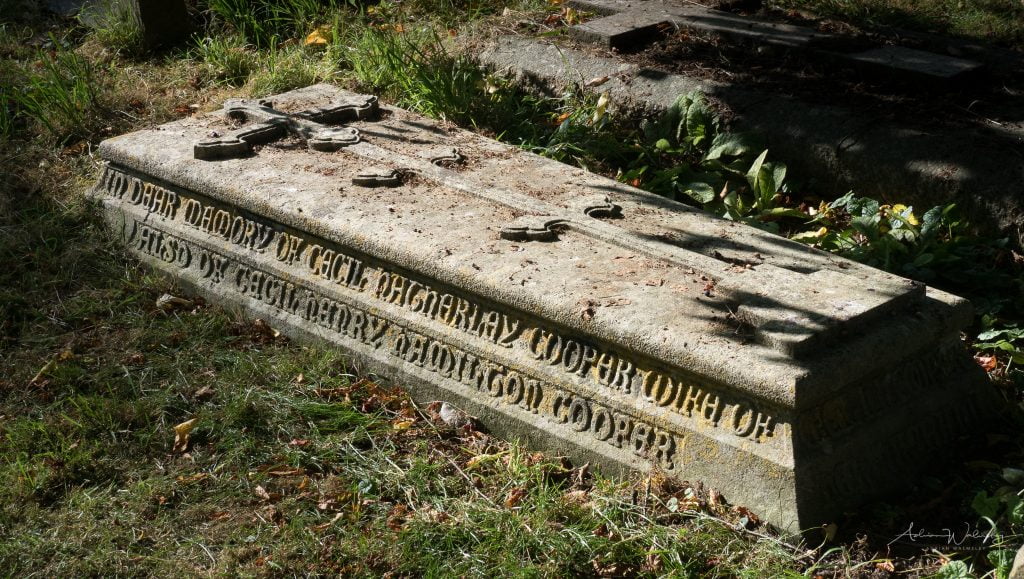
Cecil Cooper himself had always said that on retirement he would return to his old parish, and this he did. He lived here from his retirement in 1938 until his death in January 1942. He was buried in the same grave as his wife.
References
Cecil Cooper, Rector
Cecil Henry Hamilton Cooper wikipedia entry
W D Caröe, Consulting Architect
W. D. Caröe Caröe (1857-1938) was a major figure in the Arts and Crafts Movement; he was architect to the Ecclesiastical Commissioners from 1895 until his death and was architect to numerous ecclesiastical buildings including St Davids and Durham Cathedrals, and Tewkesbury and Romsey Abbeys. The firm which he founded in 1884, Caroe & Partners, still specialises in ecclesiastical architecture, especially the restoration of historic churches.
Dean Stephens
Would have become father-in-law to Cecil Cooper had he not died after eating contaminated oysters before his daughter and Cecil Cooper were married.
Dean of Winchester Very Reverend William Richard Wood Stephens DD, FSA wikipedia entry
John Barnes Colson, Architect and Churchwarden
John Colson & Son. John Colson (1820-1895) specialised in ecclesiastical architecture, almost exclusively in Hampshire, building and extending churches and parsonages. The Hampshire County Council pamphlet John Colson, a Hampshire Architect of the Victorian Age records that, in 1863-6, John Colson had rebuilt the church of Wootton St Lawrence, near Basingstoke. He had “enlarged the church by adding a south aisle, and this is the most striking feature in the church”. In 1877 he took his son, John Barnes Colson, into partnership and the practice became John Colson & Son.
John Barnes Colson (1851-1908), who lived at Red Lane House, Shawford, followed his father as Architect and Surveyor to the Dean and Chapter at Winchester Cathedral.
After his father’s death, J.B.Colson joined with Farrow and Nisbett and the practice became Colson, Farrow & Nisbett, with offices in Winchester and London. He is thought not to have enjoyed robust health, and died at a relatively early age in January 1908.
[Note: the brass plaque in Compton Church gives his age at death as 57. The obituary in The Building News and Engineering Journal, Volume 94 (Jan-June 1908) says that “he was in his fifty-fifth year”. The GRO (quarterly summary) index on the FreeBMD website gives his date of birth as Sep 1851. So he was probably 56. That is, in his 57th year.]It is natural that Robert Cope would have referred to J B Colson as the principal architect. He was the older man, and through working with his late father would have acquired much experience of extending churches.
George Herbert Kitchin, Architect
The other architect, George Herbert Kitchin (1865-1951), a “prolific architect, especially in Hampshire” (Wikipedia), was to become known for Compton End and other houses and gardens in the Arts & Crafts style. His father, Dean George William Kitchin, had been a friend of John Ruskin, whose ideas inspired the Arts & Crafts movement.
Herbert Kitchin seems to have made a speciality of wood panelling. Much, if not all, of the panelling in both the old and new sides of All Saints’ Compton dates from after the 1905 extension. The faculty records show that they were designed by Herbert Kitchin, who also designed oak memorial panelling in places of worship such as Twyford Church and St Lawrence Church, Winchester, as well as, for Twyford School, the 1895 oak reredos in the chapel and the 1923 Memorial Library. He lived at Compton End until his death at 85 in early 1951.
He merits but a single line in Wikipedia, under the entry for his father, Dean George William Kitchin.

